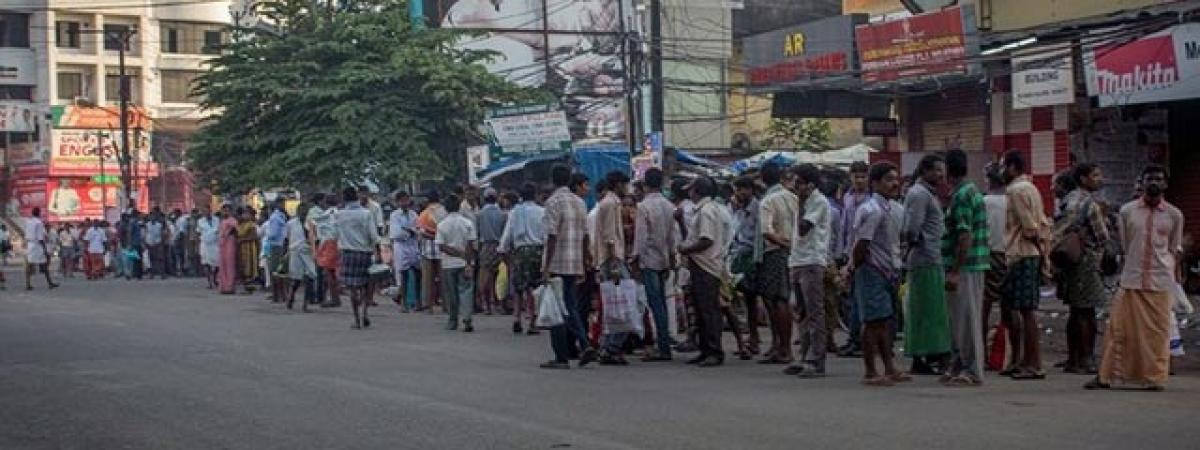Live
- Job mela at Masab Tank tomorrow
- New toilets facilitated for MPP school students
- Steps to safeguard natural springs gain momentum
- RWAs want officials to clear fog over SCB-GHMC merger
- Tanks, canals remain neglected despite execution of MGNREGS works
- BRS to celebrate Deeksha Diwas on Nov 29, Dec 9
- NCC Day grandly celebrated at SITAM
- CITU demands rollback of strategic sale of VSP
- 7-Year-old girl sexually assaulted in Tirupati
- PM Modi highlights govt's efforts to make Odisha prosperous and one of the fastest-growing states
Just In

Even after bifurcation of united Andhra Pradesh from erstwhile Madras State around 60 years ago, still majority population in southern parts of the district rely on Chennai city and other parts of Tamil Nadu to eke out their livelihood.
Nellore: Even after bifurcation of united Andhra Pradesh from erstwhile Madras State around 60 years ago, still majority population in southern parts of the district rely on Chennai city and other parts of Tamil Nadu to eke out their livelihood.
- Even after 60 years of bifurcation from erstwhile Madras state people from south Andhra districts migrate to Chennai and other parts for labour work
- Many construction workers visit the city on a daily basis for employment from Naidupet, Sullurpet and Tada mandals
This has been continuing on a regular basis for several decades now. A majority of the population from Naidupet, Sullurpet and Tada mandals visit Chennai city and other industrial places for employment and major chunk of them are construction workers.
Data indicates that Tamil Nadu is home to over a million migrant workers. Interstate migrants visiting the city for work is a phenomenon on its own. Distress migration occurs every year from major parts of Kolkata, Bihar and other places like Balangir, Bargarh, Nuapada, Sonepur, Boudh, Kalahandi and Rayagada in Odisha to Andhra Pradesh, Tamil Nadu, Karnataka and Chhattisgarh due to lack of work after kharif season.
The number of migrant workers to Chennai is estimated to be around two lakh and the daily labourers from southern parts of Andhra Pradesh is also not ignorable. “Hundreds of people form Naidupet, Sullurpet and Tada mandals basically rely on construction works in the city and the outskirts. They go early in the morning and return to their villages by evening on a regular basis.
Interestingly, people from Chirala and Tenali also visit these areas for harvesting works,” said G Padmanabaiah, CITU Sullurpet division president. He says the reasons for more migration this year from the region has been due to lack of adequate mandays from MGNREGS, local industries have been providing employment to women/girls, and severe drought situation prevailed in four mandals in the constituency were under severe famine conditions.
A survey in Chennai city also revealed that majority of the 10.67 lakh migrant workers in the entire Tamil Naidu state were unskilled workers. About 27 pc were employed in the manufacturing sector, 14 pc in textile industries and 11.41 pc in the construction sector that excluding these migrating labourers on a daily basis who were playing a crucial role in the development works in the metropolitan city.
P Armugam from Naidupet said they were visiting Chennai city for last 15 years for construction labour works. “We get 600-700 per day and local people don’t pay such huge amount. We get only Rs. 200-300 per day from local works from employment guarantee scheme and that too they are occasional. So, we prefer city based labour works for continuity through contractors,” he explained. In fact, there are around 1, 12,500 workers in Sullurpet, Naidupet and Tada mandals registered for NREGS works.
Now, after huge industrialization after 2005, many SEZs and industrial organizations have come up in the region. Still, very few educated boys and uneducated girls were getting employment in Apache, Sri City and other mobile phone making companies. One mobile making unit in the region has been providing employment to around 9,000 girls.
There have been disadvantages that some companies were preferring only girls aged between 20 and 25 and few boys were being appointed as supervisors. Uneducated people are having no option to prefer construction labour works in Chennai and other outskirts for their livelihood.
Consequently, passenger/sub-urban trains that move from Naidupet and Sullurpet areas throng with these workers who board the trains with the help of train crew from their villages even though there is no halt.
“The employment was only for women and girls and how young boys support their families? This has been making them to move to other parts for livelihood and the government is also not considering these issues. Fishermen also move to other parts for labour works during unseasonal period,” said A Dharmaiah from Arambakkam.
By PV Prasad

© 2024 Hyderabad Media House Limited/The Hans India. All rights reserved. Powered by hocalwire.com







